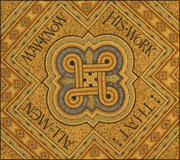 The Rotunda, dedicated in honour of Ernest and Elizabeth Samuel, is the Museum’s ceremonial entrance hall. It features one of the Museum’s most magnificent architectural treasures—a spectacular mosaic dome that has fascinated generations of staff and visitors.
The Rotunda, dedicated in honour of Ernest and Elizabeth Samuel, is the Museum’s ceremonial entrance hall. It features one of the Museum’s most magnificent architectural treasures—a spectacular mosaic dome that has fascinated generations of staff and visitors.
Charles T. Currelly, the first director of the Royal Ontario Museum of Archaeology, conceived of this mosaic introduction for the 1933 addition. The mosaic ceiling was designed to reflect the breadth of the collections, being adorned with patterns and symbols representing cultures throughout the ages and around the world.
The ceiling is made from thousands of sheets of imported Venetian glass, cut into more than a million tiny coloured squares. A team of artisans laboured for eight months to install the ceiling.
Its sparkling gold, rust and bronze background is inset with red, blue and turquoise patterns, recalling the magnificent mosaics of the Byzantine world and Eastern Europe. Worked out on the golden field are geometrical borders and panels which frame decorative floral designs. The central panel is inscribed with a passage from the Book of Job in the Old Testament: “That all men may know his work”.
 16 pictorial images symbolize different cultures throughout history:
16 pictorial images symbolize different cultures throughout history:
Representing the early cultures of the Americas
- Bison from a cave painting
- Eagle from a northwest coast crest pole
- Inca thunder god, holding snakes representing bolts of lightning
Symbols of classical cultures of the Mediterranean
- Egyptian falcon
- Mythical Greek sea-horse
-
Romulus and Remus; legendary founders of Rome

Symbols of the ancient cultures of Asia
- Winged bull, Assyria
- Magical elephant, India
- Three-clawed dragon, China
Symbols of European cultures
- Winged lion of St. Mark, emblem of Venice
- Heraldic griffin of Gothic art
- Fountain of Lions, from Islamic Alhambra in Spain
 Ancient architecture
Ancient architecture
- Mesopotamian ziggurat
- Egyptian “pylon”, entrance to a temple complex
- Classical Greek temple
- Mayan temple from Central America
